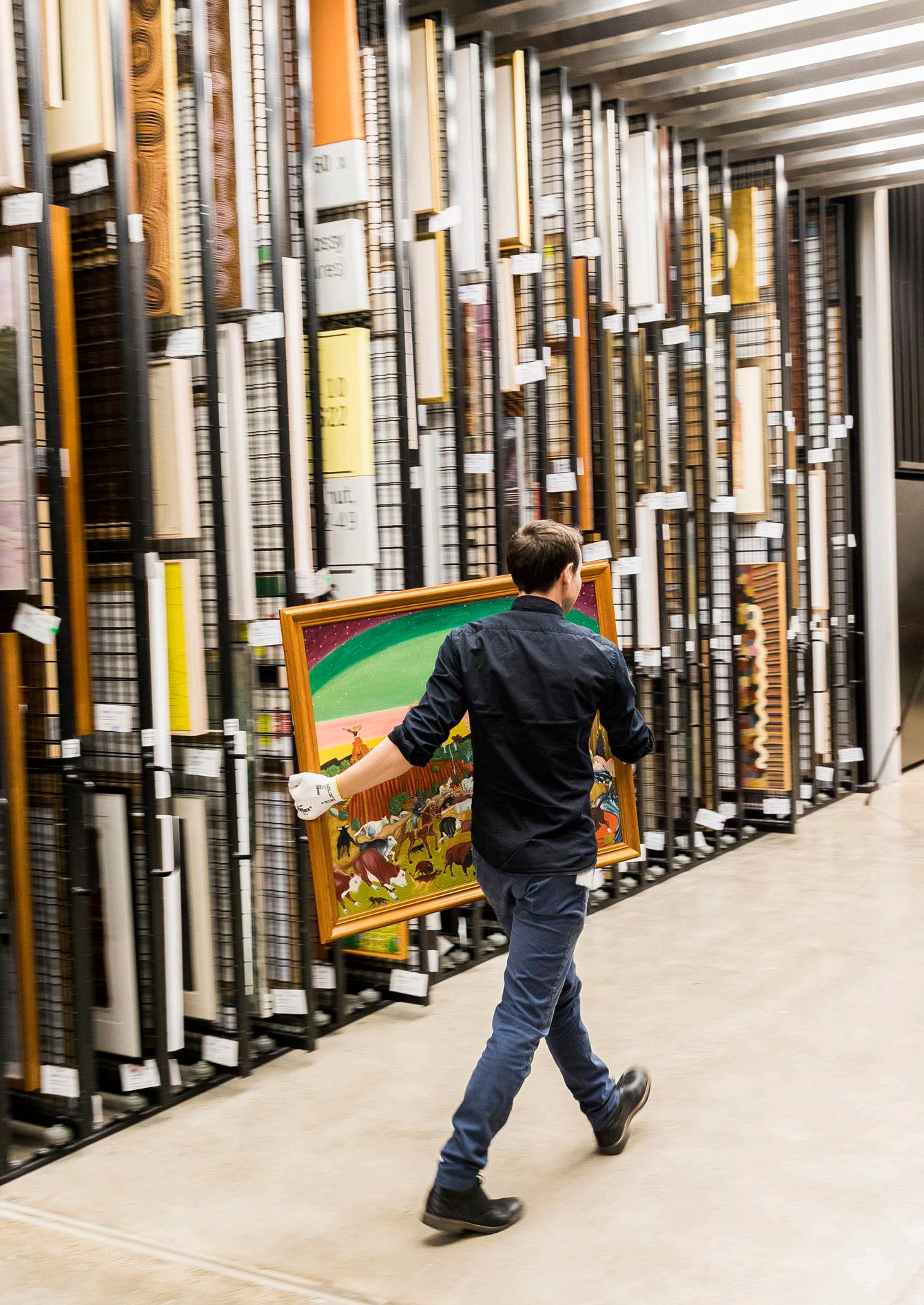

Introduction to Artbank
Artbank is a unique Government artist support and access initiative. For over 40 years we have supported thousands of Australian artists, building an impressive collection of over 10,000 artworks. Artbank artworks enrich government, business and residential spaces, exposing a wide variety of people to contemporary Australian art.
The Artbank collection was founded with an endowment of 600 artworks from the National Collection (now the National Gallery of Australia) and has since grown to include more than 10,000 works spanning media including painting, sculpture, video and photography.
Through leasing works to individuals, companies and governments, Artbank lives up to its policy principle of promoting broad access to Australian contemporary art. Through our leasing of artworks to Australian embassies and overseas posts, we provide access to Australian contemporary art in approximately 70 countries across the globe.
Artbank has similarities with other collecting institutions in how we undertake aspects of the business, but we are very different in both why we collect artwork and how we promote Australian art to stakeholders, clients and the public. For the broader community, we make Australian contemporary art accessible in ways other collecting institutions cannot.
With Artbank artworks in workplaces and other public and private places around Australia and the world, we enable the broader community to access some of the best examples of Australian contemporary art.
This allows for a different, more everyday type of engagement with artworks than a gallery or museum exhibition offers. By displaying works in offices, government buildings and homes, we present artworks to many who would never visit a public or private gallery, breaking down traditional barriers to this art form.
Browse our collection
artbank.gov.au
@instagram.com/ artbankau facebook.com/ ArtbankArt
Subscribe to eNews: artbank.gov.au/ about-artbank
Artbank Sydney, photo Tom FergusonJames ANGUS
Red I-beam Knot, 2012

Sculpture
Steel and enamel
#13696

James Angus (b. 1970, Perth, WA) is a sculptor and installation artist. Grounded in realism his work often takes surreal flights of fancy. He has increasingly turned towards more abstracted data visualisation in later years with his Day In, Day Out, 2011 outside 1 Bligh Street, Sydney his most famous work. Angus’s practice draws on natural and built forms to investigate how sculpture can mediate our perception and experience of the physical world. He collaborates with industrial designers and 3D computer engineers in the construction of his sculptures, which are made from materials ranging from fibreglass to steel.
This work pursues his interest in formal engineering structures and materials like steel beams and piping. Distorted and warped to undermine their structural integrity and purpose, this work is both hard and soft, strong and fragile. The i-beam too, here deconstructed, makes us reconsider the importance of steel in the birth of modernity, in its skyscrapers and bridges; the work undermines and celebrates this hero of modernity.
Angus studied at Yale on a Fulbright Scholarship.
MatlokGRIFFITHS
Untitled, 2021
Untitled (No. 3960), 2021
Untitled (Fragrant), 2021
Untitled, 2021
Untitled, 2021
Untitled (Kermit, Missy Piggy and Fozzie), 2021
Untitled, 2021
Untitled (No. 3915), 2021



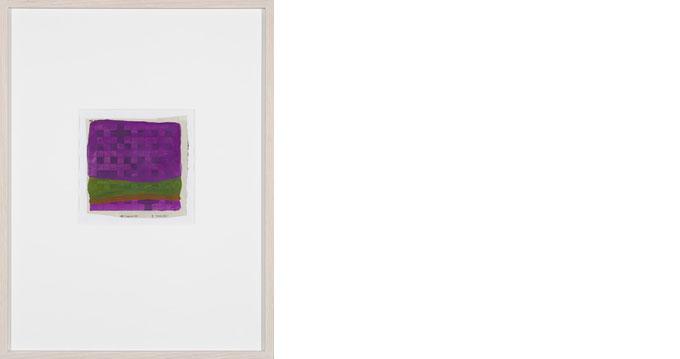
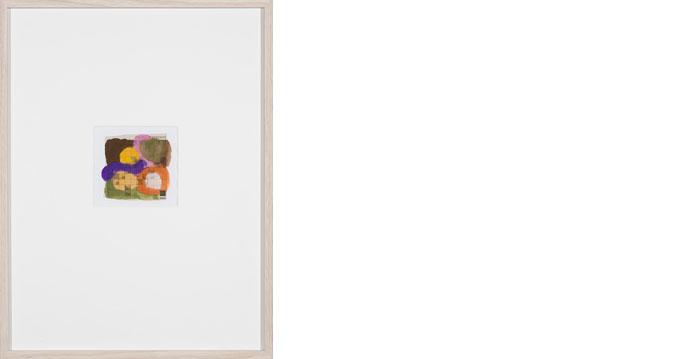
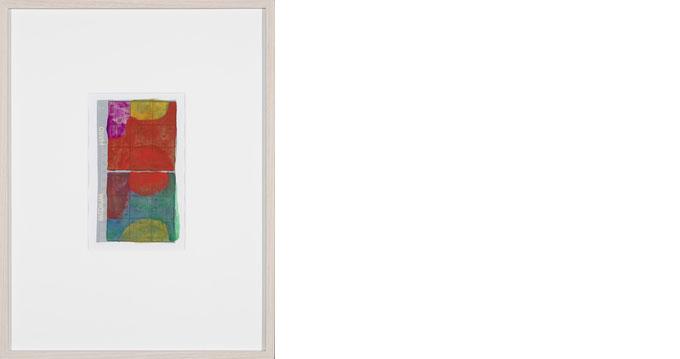
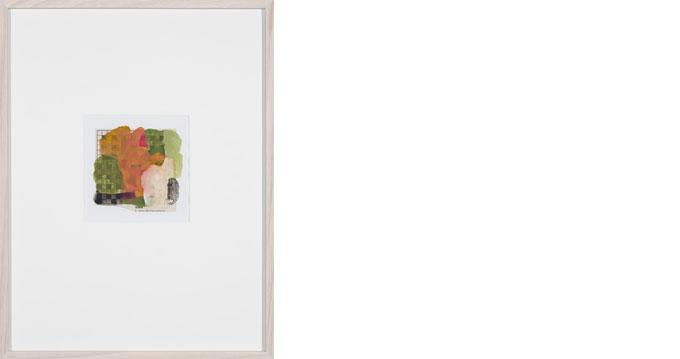
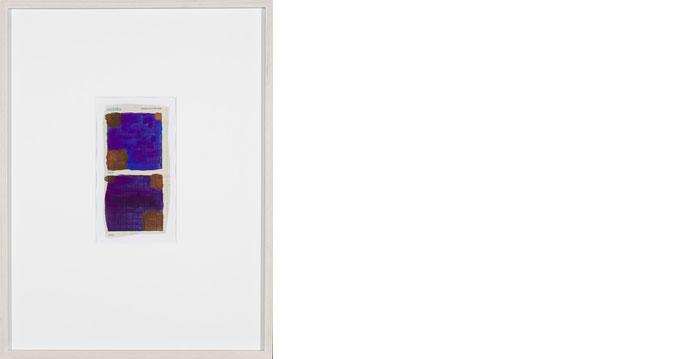

Works on paper
Gouache and newspaper on paper #16555 - 16562
Matlok Griffiths practice is inspired by everyday events, daily encounters and personal musings. The artist employs a wide-range of materials and media, including painting, sculpture, drawing and print making. The series Yesterday’s Solutions reflects on the rhythms of isolation and detachment collectively felt throughout the COVID-19 pandemic. Made from a substrate of familiar puzzles and patterns collected from newspapers and magazines, the works represent a sense of routine and order in an otherwise unprecedented time. Through habitual mark making and layering these artworks attempt to locate purpose and meaning, expressed in the patterns, rituals and agency of the artist.
Griffiths (b. 1983, Perth) lives and works in Melbourne, Australia. His work is held in the National Gallery of Victoria Collection, Melbourne; and a number of private collections nationally and internationally. Matlok is represented by ReadingRoom, Melbourne and Darren Knight Gallery in Sydney. Recent exhibitions include The Colour of Time, ReadingRoom, Melbourne (2022), The Natural Years, Darren Knight Gallery, Sydney (2022) and The Horse (2018) also at Darren Knight Gallery. Additionally the artist has published a number of books, most notably Mumbles & Clunks, Co-published by Darren Knight Gallery and ReadingRoom (2019).
Stephen BUSH
The Lure of Paris #3, 1992
Painting Oil on canvas

#8171

Stephen Bush (b. 1958, Colac, VIC; lives and works Otway Ranges, Victoria) is a painter who explores modes of representational painting and its history. Dabbling in the rich art historical territory of the Romantic and the Sublime, with a sharp twist of Surrealism, Melbourne painter Stephen Bush has forged a distinctive approach to painting. Bush delights in open ended possibilities, combining conflicting visual references that hover tantilisingly on the edge of narrative meaning that remains just out of reach. Bush notes of this, that his works often stem 'from how one wants to think of our surrounding world and its various cultures, rather than any so called real sense of how the actual world is.’
The Lure of Paris, No 3, comes from an ongoing series where Stephen Bush continues to repeat this image. As you can see Artbank has a particularly early version in collection; it is a masterpiece of the Artbank collection. If anything the image has become even more relevant. Babar is now more generally seen as a colonising figure, where an African ‘native’ learns how to be civilised in France. Bush in this work, as in other work, is commenting on the problem of Australian art, which especially in the nineties, was seen to be always on the “periphery” (from France or New York or other art centres). Alternatively Babar might represent safe middle class values.
Howard ARKLEY

Demo Space, 1994

Painting
Synthetic polymer paint on paper #8453
Howard Arkley (1951-1999, Melbourne) is considered one of Australia’s leading painters. He is known for his Popist paintings and the subjects of his work drew mainly from popular culture –suburbs, interiors and portraits. Rewriting Australian painting, Arkley turned away from nature and other “Australian” themes and looked to the suburbs. He saw beauty in the kitsch of Australian homes and garish interiors. Arkley was also embedded in the Melbourne punk scene and his portrait of Nick Cave is housed at the Portrait Gallery.
Demo Space is a characteristic subject of Arkley, it is the interior of a classic fibro cottage of the Melbourne suburbs. Painted in airbrush technique, using acrylic black paint directly onto the paper, the subject is treated with respect and seriousness. The patterning of the chair and rug, are also painted with stencils, a classic mode of graffiti art as well as interior painting. The chair is the good chair, a little retro already, dating to the 50s, it sets the work back to when the houses were made new (as opposed to when Arkley paints them). The everyday subject is elevated through the quality of the drawing. As Arkley commented: "I draw rather than paint."
In 1999, for the Australian Pavilion at the 48th Venice Biennale, Arkley created a panoramic hallucinogenic interior, which according to Arkley was appropriate because the Biennale was "like a home show."
Julia CICCARONE
Communication, 1994

Painting
Oil on canvas #8664
In the early work of Melbourne based artist Julia Ciccarone (b. 1967), her approach to painting was often autobiographical, dealing with themes of family, marriage and female roles. Ciccarone’s allegorical compositions are often layered in meaning and art historical references that they prompt further questioning from the viewer. In more recent works Ciccarone has been exploring surrealistic notions of the landscape and dreamscapes where environmental concerns meld in an alien landscape. A constant however, is her focus the deceptive illusionistic powers of representation that she manipulates to present impossible worlds within worlds.
In 'Communication' Ciccarone re-imagines a scene from her own post-wedding dinner in which she places the viewer in her place at the head of the table. Ciccarone has carefully constructed this scene with a complex sequence of interactions and glances between those present while they pass around gleaming plates and wine glasses, seemingly unaware they are completely empty. Is the artist alluding to sentiments of falseness and unhappiness?
Ciccarone won the People’s Choice at the Archibald in 2021.

Daisy Napaltjarri JUGADAI
Untitled, 1994

Painting
Synthetic polymer paint on canvas #8787
Daisy Napaltjarri Jugadai (1955-2008) was a much-loved Ikuntji painter and one of the first artists to paint at the Ikuntji Women’s Centre which opened in 1992. She was born at Haasts Bluff and is the daughter of Narputta Nangala and Timmy Jugadai. Her works are focused around the arid area of Haasts Bluff in the Northern Territory where she represents the desert flowers as lush colourful mosaics following the rains.
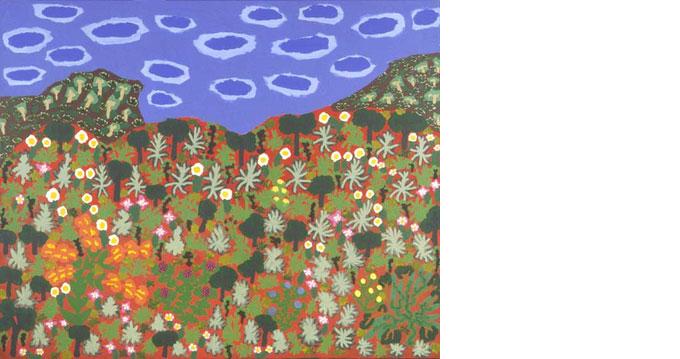
Jugadai depicts a diverse variety of food sources found in the bush and celebrates the bounty of flora available in this vital and verdant work. The foods include banana, bush cherry, bush grape, bush strawberry, bush sultanas, bush tomatoes, mulga branches with sweet sap and the sweet grevillea flower. Jugadai’s painting embodies the cultural knowledge of the Ikuntji.
Jugadai was works in significant national collections including the National Gallery of Victoria, National Gallery of Australia and the Museum and Art Gallery of the Northern Territory.
David BROMLEY
Lazy Day, 1996
Painting
Synthetic polymer paint on canvas
#9371

David Bromley (b. 1960, Sheffield, UK; immigrated to Australia with his family in 1964) is one of Australia’s most famous artists. In his practice, David has developed distinct themes and unique styles of painting. He is best known for his nude portraits and children’s series, and all have a certain whimsy with decorative elements from butterflies to expressive gestures. In his own words his work is “enduringly figurative, daringly coloured and executed with a graphic intention that is striking and memorable.” This work is an early and important piece in his oeuvre. Copying the “Boy’s Own” subject matter, in the graphic illustrative style of the mid 20th century, Bromley scales the work up in a Pop Art way, while at the same time retaining some nostalgia for the original. Many of Bromley’s paintings are set by the sea, which he suggests is a “wonderful arena upon which [the characters] can travel, [for] the sea has its own personality… has romance”, and what better setting for an artist who aims to “paint an emotion”.

Angela MACDOUGALL
Pear I and II, 1998
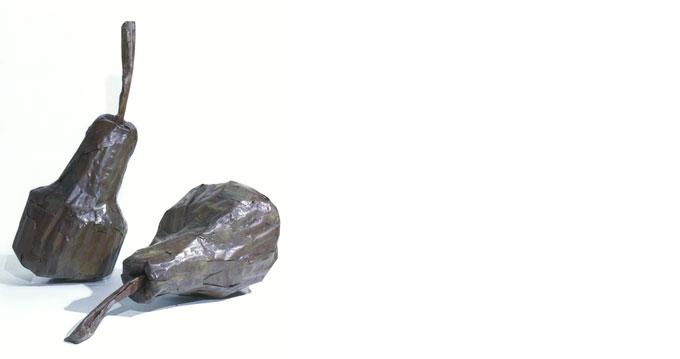
Sculpture
Sheet metal, paint and rivets
#10131 #10132

Angela MacDougall (b.
is a naïve sculptor whose works have been self-described as “kooky”. MacDougall uses found objects and ‘pre-loved’ metals, and often depicts animals or everyday organic forms. Pear I and II were exhibited as part of MacDougall’s 1999 exhibition Ripe. At the time she stated: ‘Ripe is an exhibition investigating the use of fruit and the links with human existence….
Seeds and fruit have been widely represented in art for centuries; whether it is a compositional device, religious icon, social commentator or simply as an attractive sensual form with anthropomorphic qualities.’
She travelled and worked in Osaka, Japan for two years during 1991 and 1992, and designed and constructed stage sets for Merri Shakespeare Co.'s production of The Tempest in 1994, before completing her Honours degree at RMIT, in 1996. Her awards include a Pat Corrigan Grant (1996) and she has created some exciting public commissions including those for Manningham City Council and 6 Degrees Architects.
1965, Wagga Wagga)Callum MORTON
New Caanan, Connecticut, 2003
Photography
Digital print #11201
Callum Morton (b. 1965, Montreal, Canada; lives Melbourne) has an installation and sculptural practice inspired by architecture and the built environment. His works explore human interaction with architectural space and ideas through scale models and facades of well-known buildings.

This body of work is based on hyperreal digital models. They are part utopian, as perfect models of capitalist architecture, here a petrol station. But they have elements of dystopia too, the failed dream of modernism, the graffiti on the walls pointing to social discontent, and the lack of people (an emptiness, but also a common trope of architectural images). Morton makes us relook at architecture around us and makes us think about social and economic conditions and also our cultural expectations. For example the fuel station is commonly used in film as a place of strange meetings (from Great Gatsby to Thelma and Louise, to Zoolander).
Morton represented Australia at the 2007 Venice Biennale with a scale model of his childhood home, designed and built in the 1970s in a modernist style by his architect father.

Daniel NOONAN
Just In Case Something Happens II, 2005
Painting
Oil on canvas
#11540

Daniel Noonan (b. 1974, Melbourne; lives and works in Brooklyn) is an abstract painter who in a post-modern way uses multiple styles on the one canvas, and nods to figuration. His abstractions are sophisticated balancing acts of colour and composition, in which elusive forms, figures and text emerge and dissolve. Central to Noonan’s painting approach is challenging the boundaries of the picture plane and he often uses shaped canvases. Artbank’s work is a relatively early work and the level of abstraction has not matured, having said that the L-shaped ground is almost there on the picture plane. A seeming tree house perched up high may be the precarious thing that the title intimates. 'Just in Case Something Happens II' emphasise the sense of foreboding present too within Noonan's use of forced perspective and colour.
Since 2005, the period this painting was made, Noonan has lived in New York. He has a strong international presence and shows in London and New York as well as Melbourne. His work is held by the NGV.

Grant NIMMO
Hippy Island, 2009
Painting
Oil on canvas
#12790
Melbourne based Grant Nimmo makes work about the great outdoors, and the mythologies and traditions associated with its depiction over time. He is especially interested in imagery and ideas associated with nature as a refuge from the bustle of mainstream 'civilisation'.
‘Hippy Island’ presents a humorous, topsy-turvy nod to 1960s psychedelia. The countercultural allusions to hippies and radicals orbit alongside imagery of mountains, valleys and rivers, creating a playful and engaging work. Is it me or do those apotropaic eyes turn the whole painting into a bearded, long haired man?
Nimmo (b. 1979) holds a Bachelor of Fine Art, Monash University, 2002 and has been exhibiting regularly since 2008. Exhibition highlights include 2020, 1997 – 2020, Ivan Anthony Gallery, Auckland, 2013; Art Athina Art Fair, Athens, 2013; Sixth Sense, Westspace, Melbourne, 2013. He has also been a finalist in a number of prestigious art prizes including Paul Guest Drawing Prize, Bendigo Regional Gallery, John Leslie Art Prize Finalist, Gippsland Regional Gallery and the Salon Des Refuses, National Trust Gallery, Sydney


ChristopherYOUNG
Small Town, 2012-2016
Photography
Lightjetprint


#14728
#14729
Christopher Young was born in small-town New Zealand in 1974. After finishing his studies he moved to Germany in 1996 before settling in Western Australia in 2002. Isolation is a recurring theme in his life and artwork. The remoteness of growing up in semi-rural New Zealand; the loneliness of living in Germany as a poor German speaker; and lately the geographic and ideological seclusion of life in Australia, have all coloured his artistic practice. In the 'Small Town' series, Young makes reference no place in particular, rather seeks to convey a broader sensibility of romantic quietude, tinged with nostalgia and sadness. This work was bought as part of the Perth Artbank Roadshow, in 2017.

KateTUCKER
Regroup, 2020
Painting
Linen, calico, canvas, digitally printed cotton, chux, synthetic polymer paint mediums on canvas

#15349
Kate Tucker (b. 1980, Canberra) is a Melbourne-based artist. She graduated from the Victorian College of the Arts in 2009. Tucker takes a contemporary approach to painting, exploring and subverting expected orders and processes. Frustrated with the restrictions of painting onto pre-stretched canvases, Tucker builds her works layer by layer from a range of materials, each layer presenting a new chance to shape and change the artwork’s form. These layers consist of experiments with numerous materials including painted and stained canvas and digitally printed cotton, sometimes printed with earlier versions of the work she is making in a self-referential circle.
Regroup suggests this remaking and reworking. The work is an exploration of the mass of information and images we encounter on a daily basis and the constant need to sift, organise and curate our visual consumption.
Tucker has been a finalist in the Arthur Guy Memorial Painting Prize, Geelong Contemporary Art Prize, The Substation Prize, Albany Art Prize, Bayside Acquisitive Art Prize, The Churchie Emerging Art Prize, Geelong Acquisitive Print Awards, and The Archibald Prize. Her work is held in the Shepparton Art Museum Collection, The Bowerman Collection and a number of private collections in Australia and overseas.

Balgo Collaborative

Dulcie Nanala, Tossie Baadjo, Miriam Baadjo, Matthew West, Helicopter Tjungurrayi, Vincent Nanala, Jane Gimmie, Ann (Frances) Nowee, Helen
Nagomara & Angie Topsy Tchooga.
Wirrimanu
(Balgo)
storys, 2021
Painting
Acrylic on linen #16526
‘Wirrimanu (Balgo) storys’ is a rich collaborative piece that brings together the community in communal storytelling and the passing on of knowledge from elders to the younger members. Singing, dancing the story and social interaction are important parts of making. This work was painted by the Balgo Collaborative: Dulcie Nanala, Tossie Baadjo, Miriam Baadjo, Matthew West, Helicopter Tjungurrayi, Vincent Nanala, Jane Gimmie, Ann (Frances) Nowee, Helen Nagomara & Angie Topsy Tchooga. Balgo is one community that paints out of Warlayirti Artists which has been operating since 1987, and was one of the first desert art centres to open in Western Australia. Balgo has established a distinctive style of desert artwork, being amongst the first group of desert artists to embrace a broad palette of colours (not least to represent the array of desert flowers).
This work represents the big story of Balgo or Wirrimanu. The story is a desert story. Balgo sits on the borders of the Great Sandy and Tanami Deserts, as it strides the Luurnpa white kingfisher songline and overlooks a key Wati Kutjarra (two Tingari Brothers) Dreaming site. The painting sets out the important landmarks for these stories and also highlights important soakholes and waterholes which are also part of this dreaming journey across the land.

Grace ROBINYA
Mt Wedge Raining, 2021
Painting
Synthetic polymer paint on canvas #16564
Robinya was born 1942 and raised in Ntaria (Hermannsburg), her father was a Rubuntja from Mt Hay (Urre), and her mother was an Ungkwanaka from Running Water (Irremangkere). She was one of the first artists to paint with Tangentyere Artists. Robinya’s figurative paintings, often near miniatures, detail important locations and events in her life: her childhood at Hermannsburg Mission and surrounding Ntaria region, or visits to Irremangkere. She also records details of station life at Coniston and Napperby Stations, where she and her husband worked as a domestic, and ringer respectively, while raising their family.
This work 'Mt Wedge Raining' is a strong rhythmic piece which shows rain clouds over Mt Wedge. Grace says of this work, “Kwatye atnyeme, kwatye urewe – All the rain falling, all the water flowing.” Her work depicts six striking sheets of blue rain falling from clouds above burnt-orange hills around Napperby Station, where Robinya and her husband worked and raised their family "It's always raining [during] summertime, when stockmen [are] mustering," she said. "[It] makes those hills look blue in the north."

Robinya links the work to the social history of the place but when read in the context of other artists, there is also a spiritual significance which has not been explicitly mentioned. In 2021 she won the Vincent Lingiari Art Award for a work of the same theme.

Bulthirrirri WUNUŊMURRA

Waŋupini, 2022
Ceramics
Earth pigments on ceramic
#16614
Bulthirrirri Wunuŋmurra (b. 1981) is an artist from east Arnhem Land. Her grandfather was Yanggarriny, a great Dhalwangu clan leader and artist. Her father by Yolŋu law is artist Nawurapu Wunuŋmurra. Following the passing of Nawurapu, she has assumed responsibility for the creation of art in his themes, maintaining her families' artistic heritage through her own practice.
‘Waŋupini’ is a series of Makassan pots which are decorated in a highly patterned zig-zagged triangle design which represents Waŋupini (clouds) and sails as well as the artists homeland Gurrumuru. It incorporates mythology stemming from dance and song, and tales of the Makaasan coming to these areas up until the beginning of this century.
Bulthirrirri’s father travelled to Makassar in Sulawesi, Indonesia in 2015 and brought back a ceramic pot in the traditional form which Bugis seafarers had used in the trade with Yolŋu going back to the 1600’s. After his death in 2018, Bulthirrirri continued this genre with pots sent by her Father’s friend in Sulawesi. These pots would come from Makassar, filled with consumables such as palm wine, tobacco, tamarind, other spices, rice and water for the journey.

Tim McMONAGLE

Sunday Morning Coming Down, 2004
Painting Oil on linen #11401
Melbourne based painter, Tim McMonagle (b. 1971) gleans inspiration from his everyday surroundings as well as drawing on the rich resources of his imagination. As though recording the remnants of dream, McMonagle explores the evocative qualities of a fine balance between figurative elements and implied forms. Here, in 'Sunday Morning Coming Down', with a simplified, darkened tonal palette and a translucent, almost ephemeral quality to his mark making, McMonagle conveys the melancholy associated with the Kris Kristofferson lyrics to the song of the same name made famous by Johnny Cash.


Caring for your collection
Follow these tips
In welcoming Artbank works into your space, follow these tips on looking after them for us;
• Advise any cleaning staff to take great care when cleaning areas around artworks.
• Contact your consultant if a work needs maintenance like dusting or cleaning.
• Please ensure the artworks remain untouched and left where they were installed.
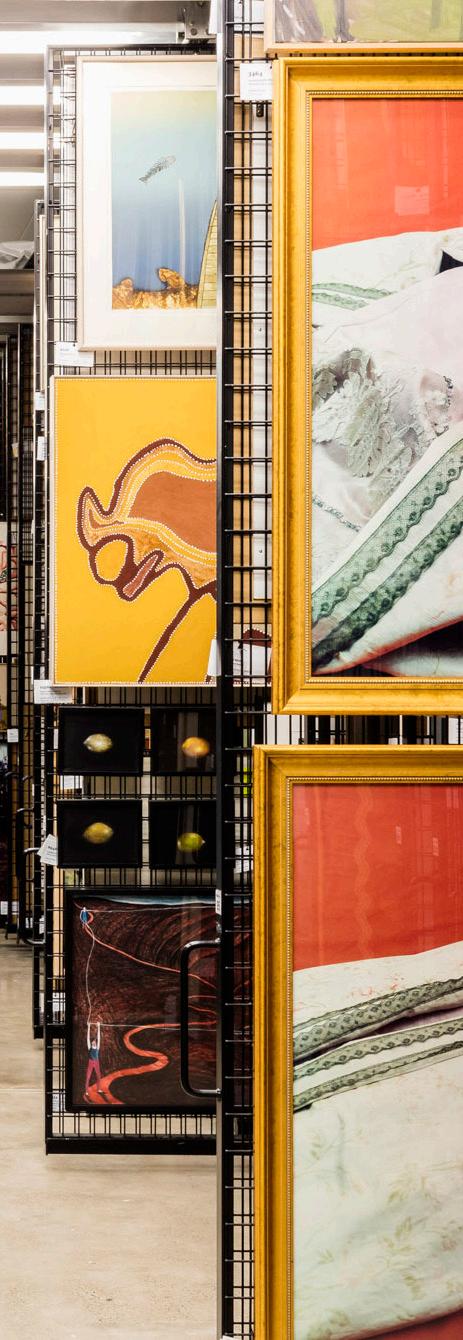
• If you need the artworks moved – just call us! We will arrange this straight away for you.
• If you notice damage to any work let us know straight away so we can save the artwork.
Sign up to our Artbank newsletter
Tom Ferguson
Telephone: 1800 251 651
Get in touch with an Artbank Consultant today and help support the Australian contemporary artists of tomorrow!
